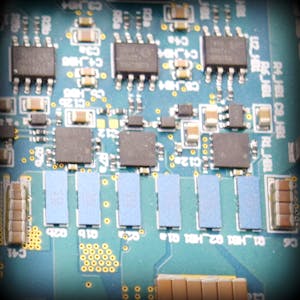The Complete Electronics Course: Analog Hardware Design
Introduction
Electronics—especially analog circuit design—can feel intimidating to many. The abstract equations, the invisible flow of current, the nuance of component choices… it all seems mystical. That’s where The Complete Electronics Course: Analog Hardware Design comes in. This Udemy course, created by Hardware Academy, promises to take you from basics to advanced analog circuits, covering over 100 circuits along the way. Udemy+1
In this blog, I’ll walk you through what the course offers, what works well, where it could improve, and how to get the most from it (if you choose to enroll).
What the Course Covers
Here’s a breakdown of key elements & structure:
1. Foundational Concepts
-
Starts with Ohm’s Law, basic voltage, current, resistance.
-
Introduces DC vs AC, Kirchhoff’s laws, power basics.
-
Covers capacitors, inductors, and their behavior in circuits.
2. Diodes, Transistors & Intermediate Circuits
-
Diode circuits: half-wave, full-wave rectifiers, Zener references, clamping, limiters.
-
Bipolar junction transistors (BJTs) in different configurations, biasing methods, amplifiers.
-
Some coverage of MOSFETs and switching circuits.
3. Operational Amplifiers & Advanced Topics
-
Op-amp fundamentals: inverting, non-inverting, buffer, summing, differential, integrators/ differentiators.
-
Precision rectifier circuits, filters (low-pass, high-pass, band-pass, notch), and various filter topologies (Butterworth, Chebyshev, etc.).
-
Audio amplifier classes (Class A, B, AB etc.), power supply design, voltage regulators.
-
Signal modulation, radio circuits, and more “miscellaneous stuff.”
4. Hands-On / Simulation & Quizzes
-
Uses a free circuit simulator tool for learners to test their designs. Udemy+1
-
Frequent quizzes and exercises at the end of chapters to ensure understanding.
-
The course claims to compress ~2 years of analog hardware design learning into its curriculum. Udemy+1
Strengths & What Works Well
Here are the major advantages of this course (based on reviews, curriculum, and student feedback):
-
Comprehensive Scope
It doesn’t limit itself to basics — it goes into advanced analog topics, which many “beginner electronics” courses often skip. -
Structured Learning with Quizzes
The regular quizzes help the learner stay engaged and test comprehension before moving forward. -
Simulator-Based Practice
Even if you don’t have a physical lab, you can experiment with circuits digitally. This lowers the barrier for beginners. -
Well-Paced Explanations
Many students appreciate that the instructor builds from the ground up, explaining each concept in simple terms before advancing. Value for Money Given how much content is packed (from fundamentals to power supplies and op-amps), many feel it offers good ROI for an online course.
Weaknesses / Things to Be Aware Of
No course is perfect. Here are some caveats and areas you may want to complement:
-
Theory-Heavy at the Start
Some learners find the opening lessons a bit slow or overly theoretical before getting into “fun” circuits. In forums, learners sometimes mention that early lessons are more lecture than hands-on. > “It’s extremely long so you have to be fairly dedicated … the teacher has a ‘sit and watch me do this’ style.” -
Limited Physical Lab Exposure
Since much relies on simulation, you might not get as much experience wiring real circuits or debugging in real hardware unless you supplement it. -
Breadth vs Depth Tradeoffs
Because the course covers so many topics, some might feel certain advanced topics are touched upon rather than explored deeply. -
Instructor Interaction / Support
As with many MOOCs, direct interaction with the instructor may be limited. If you get stuck in a particular circuit or concept, you may need to rely on discussion forums or external resources. -
Pacing & Self-Discipline Requirement
With such a broad syllabus, staying consistent matters. If you skip lessons or move too fast, you might lose the fundamentals.
Tips to Get the Most from the Course
If you decide to take this course (or any analog electronics course), here are some strategies to maximize your learning:
-
Don’t Skip Simulations
Try to re-create the circuits in the simulator yourself (not just follow along). Change parameters, see how it affects the behavior. -
Use a Small Breadboard Kit
Alongside simulation, get a small electronics kit (resistors, capacitors, transistors, op-amps, etc.). Build a few of the circuits you studied. Physical wiring and measurement teach you things simulation can’t (parasitics, noise, nonideal behavior). -
Revisit Basics Frequently
The early material (Ohm’s law, Kirchhoff laws) may feel trivial — but they are your foundation. Whenever you solve a circuit, try to trace it back to fundamentals. -
Maintain a Notebook / Journal
Write short summaries of what you learned, draw hand circuits, annotate key formulas. Having something to review helps retention. -
Use External References
-
The Art of Electronics by Horowitz & Hill is a classic reference for analog design.
-
TI’s “Op Amps for Everyone” is useful for getting intuition behind op-amp circuits.
-
Forums and electronics communities (Reddit, EE StackExchange) for troubleshooting real problems.
-
-
Apply a Mini Project
Near the end (or midway), pick a small project (e.g. audio amplifier, LED driver, small filter) and design it yourself — from component selection to simulation and if possible, physical build. That consolidates learning. -
Don’t Rush
Micro-learning in analog electronics can backfire. If a concept doesn’t click, spend time reworking problems until it becomes clear.
Who Should Take This Course? Join Now
This course is ideal for:
-
Beginners who want a structured, guided path into analog electronics
-
Hobbyists wanting to understand how everyday analog circuits work
-
Students of ECE/EE looking to supplement their coursework
-
Engineers from digital/software background wanting to dip into hardware design
It may be less suitable if:
-
You already have advanced analog design experience and want ultra-deep specialization in niche domains (e.g. RF, IC layout)
-
You only want hardware and no theory — you’ll still need to grapple with equations, concepts, derivations
Final Thoughts
The Complete Electronics Course: Analog Hardware Design is a strong curriculum for diving into analog electronics, especially for self-learners. It combines theory, simulation, guided exercises, and paced learning to bring you from fundamentals to more complex topics.
That said, success depends heavily on consistent effort and hands-on practice. If you pair it with physical experiments, external references, and a mindset of exploration, you can transform the knowledge into skills.
























No comments